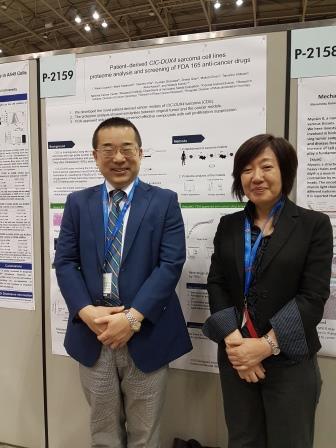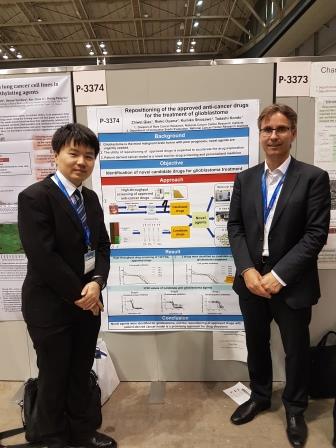Dr. Tadashi Kondo and researchers from the National Cancer Center (NCC) presented posters with novel insights into therapeutic target discovery and strategy using PamGene data, at the 76th Annual meeting of the Japanese Cancer Association, September 28th-30th 2017.

P-2091 Friday September 29th, 2017 Poster Session: Epigenetic regulation
Src pathway is a possible therapeutic target, in combination with HDACi, for CTCL
Nozomi Jimura1,2, Kazuyasu Fujii1, Shii Kyou2, Rieko Oyama2, Tadashi Kondo2, Takuro Kanekura1 (1Dept. Dermatol., Kagoshima Univ. Grad. Sch. Med. & Dent. Sci., 2Div. Rare Cancer Res., Nat. Cancer Ctr. Res. Inst.)
REQUEST POSTER
The effect of histone deacetylase inhibitors (HDACi) as monotherapy for patients with cutaneous T-cell lymphoma (CTCL) are limited. To find the candidate targets of combination therapy with HDACi, we performed the exhaustive protein tyrosine kinase assay of 3 CTCL cell lines (Hut78, HH and MJ) with 3 HDACi (romidepsin, vorinostat and belinostat) by PamChip and found that HDACi-treatment induced phosphorylation of Annexin A2 (9 out of 9 tested combinations), paxillin and embryonal Fyn-associated substrate (8 out of 9). As there are no commercially available specific inhibitors of these molecules, we focussed on Src, a common upstream tyrosine kinase of these identified molecules. Single use of ponatininb, a Src inhibitor, did not affect apoptosis in Hut78 and HH cell lines, while ponatinib enhanced the apoptotic effect of romidepsin. In conclusion, we identified Src pathway as a possible therapeutic target in combination with HDACi, for CLTL.
P-2159 Friday September 29th, 2017 Poster Session: Cancer cell line
Proteome analysis and screening of FDA 165 anti-cancer drugs against patient-derived CIC-DUX4 sarcoma cell lines
Rieko Oyama1, Mami Takahashi2, Yasuhito Arai3, Kumiko Shiozawa4, Zhiwei Qiao4, Makoto Endo5,6, Tatsuhiro Shibata3, Akira Kawai5,6, Tadashi Konod1,4 (1Dept. Innovative Seeds Evaluation, Natl. Cancer Ctr. Res. Inst., 2Central Animal Div., Natl. Cancer Ctr. Res. Inst., 3Div. of Cancer Genomics, Natl. Cancer Ctr. Res. Inst., 4Div. of Rare Cancer Res., Natl. Cancer Ctr. Res. Inst., 5Rare Cancer Ctr., Natl. Cancer Ctr. Hosp., 6Dept. Musculoskeltal Oncol., Natl. Cancer Ctr. Hosp.)
REQUEST POSTER
CIC-DUX4 sarcoma (CDS) is an Ewing-like sarcoma, a group of rare, mesenchymal, small round cell tumours that harbour the CIC-DUX4 gene fusion. CDS exhibits an aggressive course and poor clinical outcome. The objective of this study is to develop a novel patient-derived cancer model of CDS. We successfully generated two CDS cell lines from the grafted tumours. The xenografts were histologically similar to the original patient tumour, and the expression of typical biomarkers was confirmed in the cell lines. Moreover, the xenograft tumours and cell lines displayed high Src kinase activities, by peptide-based tyrosine kinase array. Upon screening 165 FDA-approved anti-cancer drugs, we found that actinomycine D and doxorubicin were effectively suppress the proliferation among the drugs for standard therapy for Ewing sarcoma. Further, we identified molecular targeting reagents, such as bortezomib and crizotinib that markedly suppressed CDS Cells growth. Our models will be useful modalities to develop novel therapeutic strategies against CDS.
P-3374 Saturday September 30th, 2017 Poster Session: Drug Sensitivity
Repositioning of the approved anti-cancer drugs for the treatment of glioblastoma
Zhiwei Qiao1, Rieko Oyama2, Kumiko Shiozawa1, Tadasho Kondo1 (1Div. of Rare Cancer Res., Natl. Cancer Ctr. Res. Inst.,2Dept. Innovative Seeds Evaluation, Natl. Cancer Ctr. Res. Inst.)
REQUEST POSTER
Summary from Poster: Glioblastoma is the most malignant brain tumor with poor prognosis, necessitating an urgent need for novel agents. The utility of repositioning approved drugs is expected to accelerate the drug exploration. Patient derived cancer model is a novel tool for drug screening and personalized medicine. In this study, novel agents were identified for glioblastoma and the data showed that repositioning of approved drugs with PDX cancer model is a promising approach for drug discovery.




